

The first element of any successful brand is the mission statement. I know this might sound obvious to some, but whether you’re a solo entrepreneur just starting out or the leader of a 50+ person team, its easy to get lost in the hustle and bustle without clearly and simply establishing your mission. Over time, you could find yourself in a totally different direction only to wonder where you went wrong…
Mission statements are a powerful tool for aligning and promoting your business by simply answering the question, “Why do we exist?” When you can quickly and easily answer that question, your mission statement creates a direction that you and your staff. Your customers can then follow suite shaping your goals, impact, and ultimately your public perception.
First, let’s dive into why you still need a mission statement.
Why is a mission statement important?
There are countless benefits to having a mission statement so by simply putting your thoughts on paper you will start to see the results come alive.
1. Mission gives direction. A mission statement is the guiding North Star that helps you stay on the path towards your goals and keeps it top of mind for both, your employees, and your customers. It should be broad enough so that its never-changing, but specific enough to keep you focused and bring clarity no matter what challenges or obstacles come your way.
2. Mission lends clarity. A clear, concise mission statement not only informs what you should be focused on, but it also helps you set boundaries for things that have little importance within your business. (Reminder: It’s okay to say no sometimes). The mission statement can guide your decision making process, and reinforce why those decisions were made, keeping everyone on the same page for a bright future.
3. Mission fosters customer engagement. A mission statement publicly describes your goal to your customers and sends a clear message to your audience. In fact, your mission alone can be the very thing that initially attracts them to you and your work. It’s up to you, over time, if you consistently deliver on that mission.
4. Mission inspires loyalty. Your mission statement isn’t just for your external use, but rather, its just as important for building your team culture! 88% of employees believe a strong company culture is key to business success. Once your team can grab ahold of the mission, they can boldly carry it out giving you better ideas and faster results.
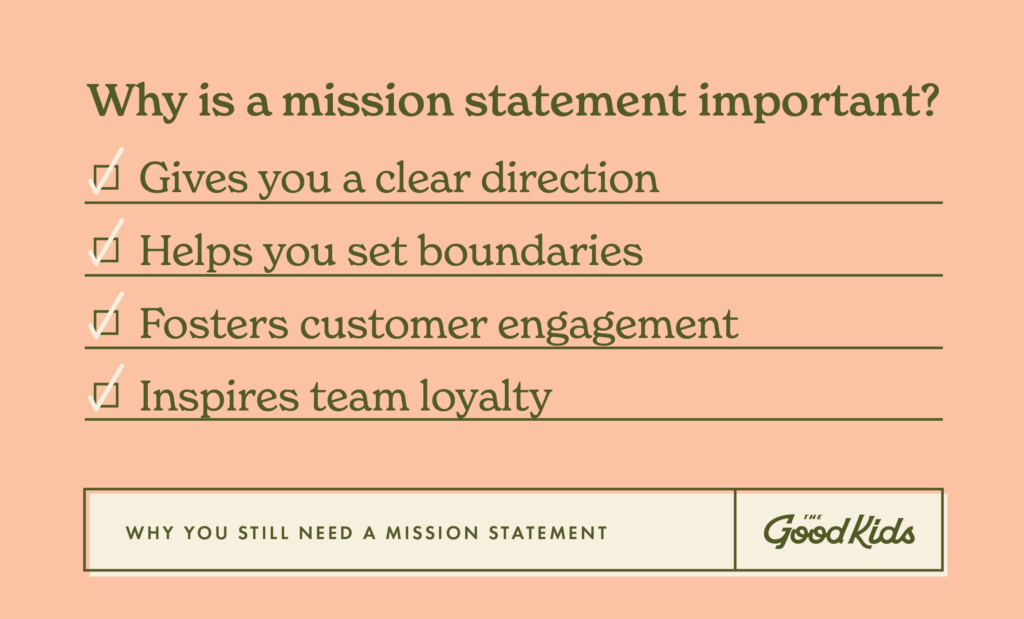
Examples of Mission Statements
A simple Google search will show you some examples, but we wanted to feature some of our favorites so you can see the diverse range of how they are written, yet see how they all answer the question, “Why do we exist?”
- Amazon: To be Earth’s most customer-centric company.
- Tesla: To accelerate the world’s transition to sustainable energy.
- Costco: To continually provide our members with quality goods and services at the lowest possible prices.
- Life is Good: To spread the power of optimism.
- Patagonia: Build the best product, cause no unnecessary harm, use business to inspire and implement solutions to the environmental crisis.
- Warby Parker: To offer designer eyewear at a revolutionary price, while leading the way for socially conscious businesses.
- Honest Tea: To create and promote great-tasting, healthy, organic beverages.
- IKEA: To create a better everyday life for the many people.
- Nordstrom: To give customers the most compelling shopping experience possible.
- JetBlue: To inspire humanity – both in the air and on the ground.
- Prezi: To reinvent how people share knowledge, tell stories, and inspire their audiences to act.
- Invisible Children: To end violence and exploitation facing our world’s most isolated and vulnerable communities.
- TED: Spread ideas.
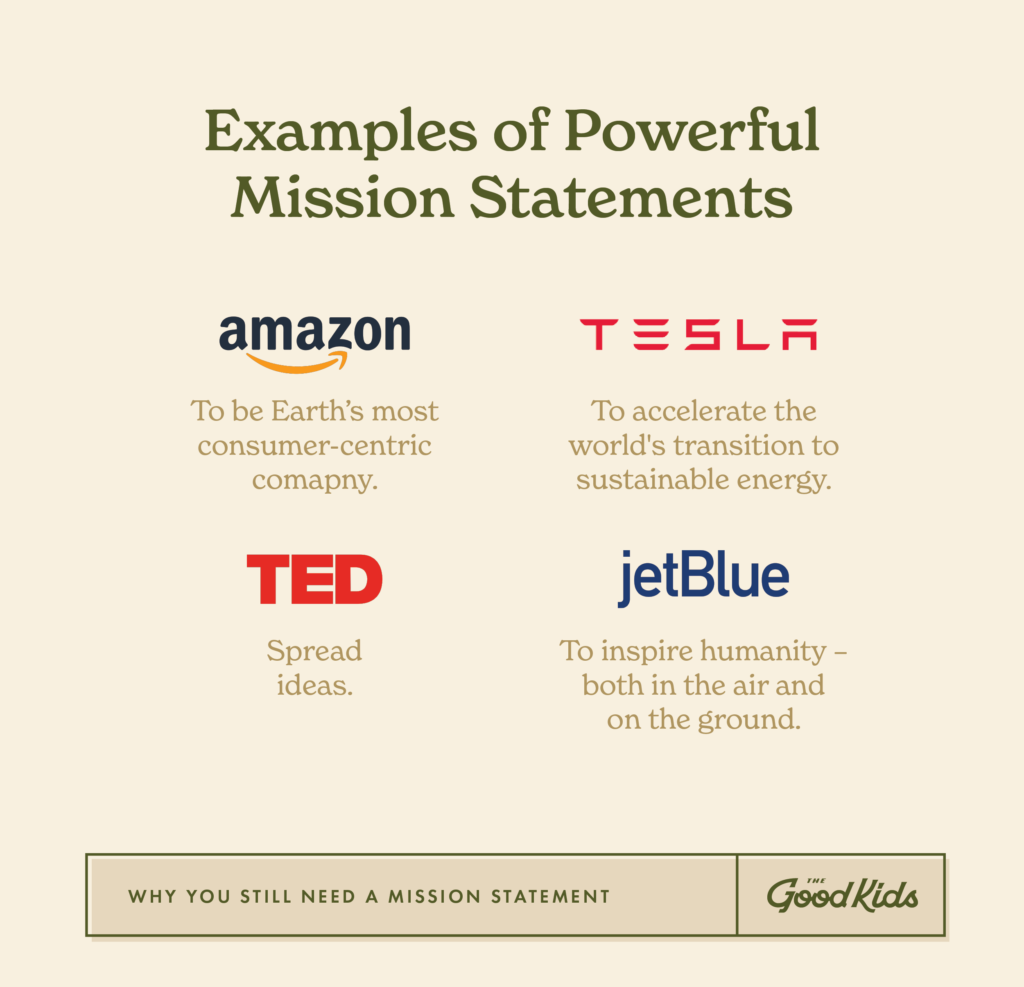
How To Write Your Own Mission Statement
The goal of writing your mission statement is to focus in on why your business exists. Its typically easy to explain what you do (i.e. the services you offer or the product you sell) but in order to find the true purpose behind why you exist, we need to look a little deeper.
For this, we’re going to use a little help from of our favorite authors and speakers, Simon Sinek. Sinek’s theory is that successfully communicating the passion behind the ‘Why’ helps you connect with the listener’s limbic brain where trust and loyalty is born. In his book, Start With Why, he suggests using the Golden Circle that we’ll use today.
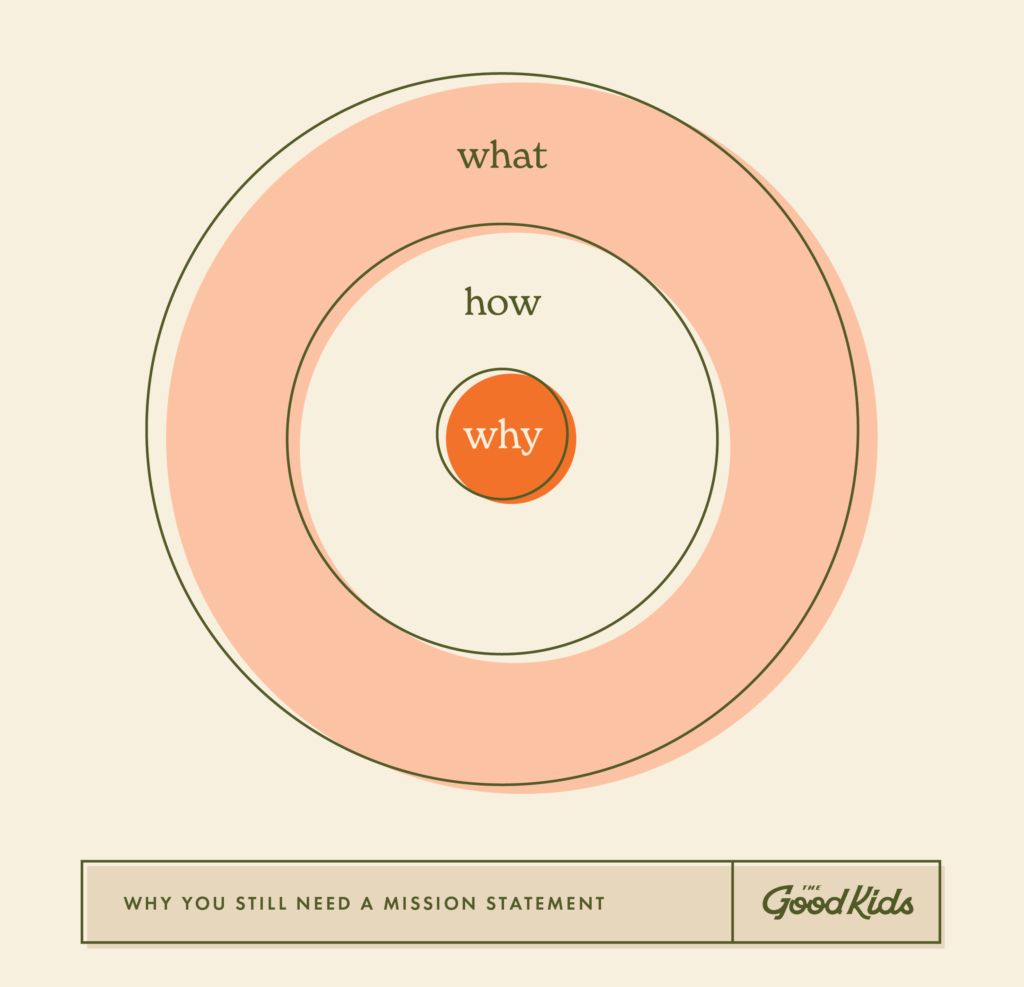
HERE’S HOW TO FIND YOUR WHY:
Step 1: List out all of the ‘what’ in your business.
(I.e. At The Good Kids, we create efficient brands that help businesses grow.)
- What does your business do for customers and employees?
- What defines success for you?
- What do you get paid to do?
Step 2: Now write out ‘how’ you do it.
(I.e. We focus on brand strategy so that every design decision hits the goal at hand.)
- How is your product different than your competition?
- How does your process make you stand out?
- How do you conduct your team differently than others?
Step 3: Identify your ‘why’ that encompasses your motivation behind the work.
(I.e. To give a voice to impactful ideas.)
- Why do you believe in what you’re providing?
- Why does your service matter to the world?
- Why do you exist?
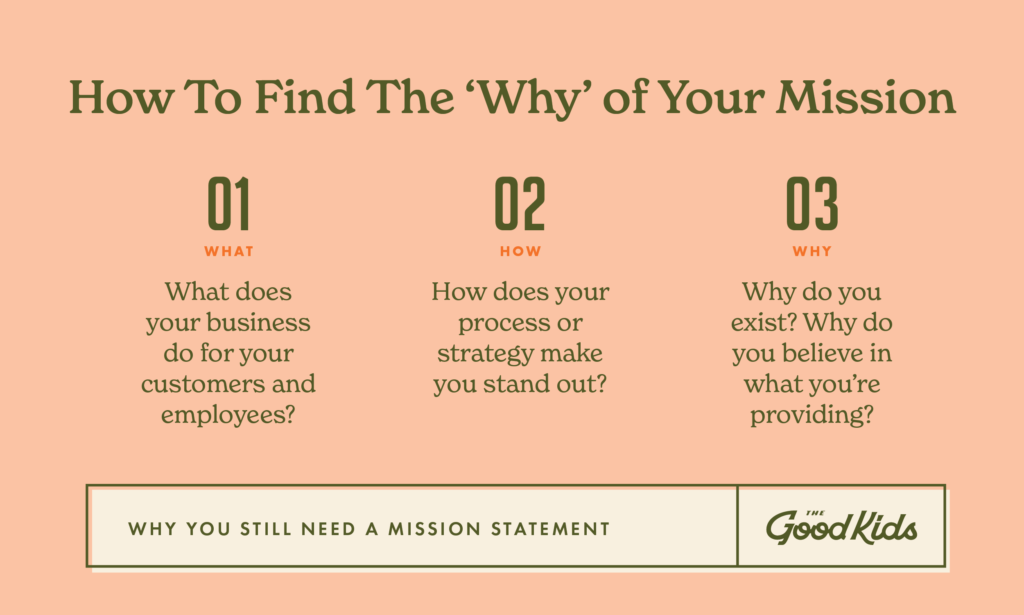
Now that you’ve gone through the ideation process, its time to start writing out some draft mission statements. It might not come to you right away, which is totally normal, so feel free to use pencil or be ready to lots of tweaking to your word doc.
An easy template to start with is ‘To _________ so that ________’ but as you can see from the above examples, it’s totally okay to make it yours as there’s no hard rule. Your mission statement doesn’t have to be clever or catchy, just accurate.
Once you nail down a mission statement that seems pretty accurate, let it sit with you for a day or two. Ponder it, tell it to one person you’re really close with, and let it sink in.
ONCE YOU RETURN TO IT, ASK YOURSELF THESE QUESTIONS:
- Does it encompass the purpose behind what you create?
- Does it give you room to explore other variations of your services and products?
- While also giving you a clear direction as your business grows?
- Does it communicate why you’re different than your competitors?
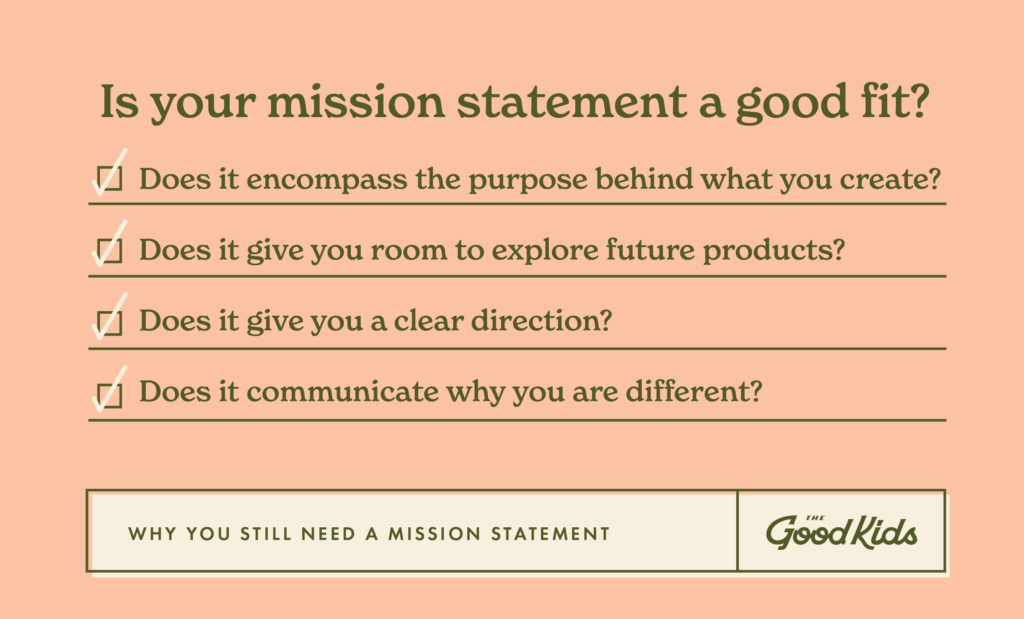
If the answer is ‘yes’ than you’re ready to start sharing your mission with both your team and then your customers so you can start seeing the many benefits of your mission at work.
If the answer is ‘no’ that’s okay! A mission statement is very important, so its not something to be rushed. Try doing the exercise again with someone you trust like a partner, mentor, or board member.
Mission Statements Put To Work
Now it’s time to put your mission to work! Below is a variety of ways you can use your mission statement both internally and externally to keep your purpose front and center in all the work you do.
10 WAYS TO PRACTICALLY USE YOUR MISSION STATEMENT:
- Display your mission statement somewhere in the office so everyone sees it on a regular basis.
- Use the mission statement to start developing your elevator pitch.
- When interviewing potential employees, ask questions around your mission statement to see if they would be a good culture fit.
- Include your mission statement in your team’s onboarding process.
- Share success stories that demonstrate the mission in action and acknowledge team members who embrace them.
- When reflecting on the past year or brainstorming future goals for the business, use the mission statement to help you focus in on what matters most
- When new opportunities or difficult decisions arise, ask yourself if it aligns with your mission. If not, you have full permission to say ‘no’.
- Share your mission with your customers online (i.e. website, social media, etc.)
- Include your mission on your packaging so customers can capture the heart behind the product
- Give back to your community by finding an organization that aligns with your same mission
Now you’re all set!
Ready to take another stab at your mission statement? We’ve created a FREE worksheet to help you narrow in on your “why” so your mission statement has impact and connects with your audience.

Whatever you choose to do, don’t keep your mission silent or hidden away. In today’s world, customers wand a cause they can support and a brand they can fully stand behind, so be vulnerable and share your purpose with pride and confidence.

